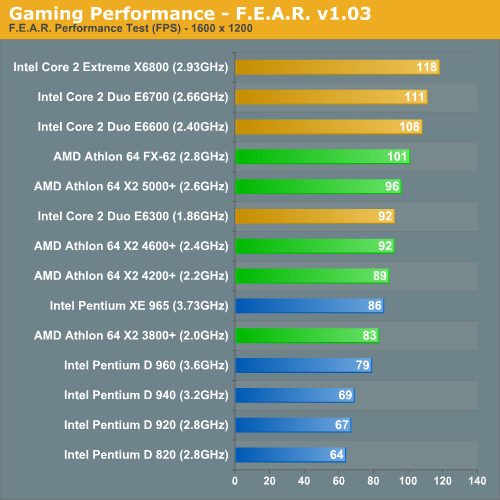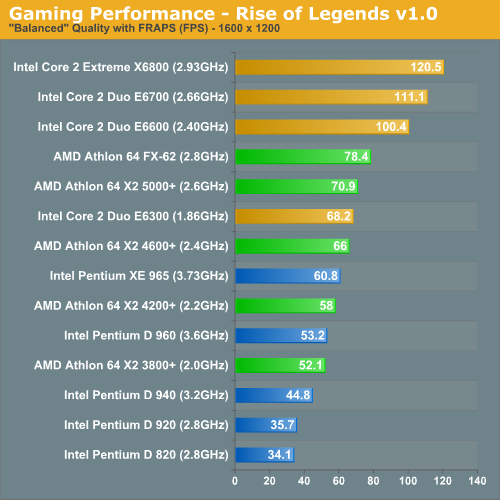Intel's Core 2 Extreme & Core 2 Duo: The Empire Strikes Back
by Anand Lal Shimpi on July 14, 2006 12:00 AM EST- Posted in
- CPUs
Gaming Performance using F.E.A.R. & Rise of Legends
Our F.E.A.R. test should be fairly familiar by now, as it is the built in performance test included with the game. Computer settings were left at "Maximum" while the graphics settings were set to "High" with the resolution cranked up to 1600 x 1200. F.E.A.R. ends up still being more GPU than CPU bound at these settings, even with a pair of X1900 XTs at its disposal, but we do see some separation among the processors:

The top three spots still go to the top three Core 2 CPUs, with the E6300 falling around the level of the X2 4600+. A trend that we've been seeing all throughout this review is that the performance of these CPUs effectively falls into three groups: Core 2 processors at the top, Athlon 64 X2s in the middle and Pentium D at the very bottom of the charts. In a sense that's the easiest way to classify these three groups of processors: if you want the fastest it's Core 2, mid-range goes to the Athlon 64 X2 and if you don't like good performance there's always the Pentium D.
Rise of Legends is a newcomer to our game benchmark suite and what an excellent addition it is. This Real Time Strategy game looks very good and plays well too; it serves as good filler until the next Command & Conquer title eventually arrives for those looking for a RTS fix. We ran with the resolution set to 1600 x 1200 and the graphics settings set to the medium defaults. We recorded a custom playback of a 3 vs. 2 multiplayer battle and played it back at 4x speed, recording the average frame rate for 10 minutes of the battle. The 10 minutes we focused on contained a good mix of light skirmishes between opponents, base/resource management with very few characters on the screen and of course some very large scale battles.

As with most RTSes, Rise of Legends is extremely CPU bound. The performance variability between runs was fairly high in this test, mainly because of how disk intensive the playback can get. Differences in performance of up to 5% should be ignored, but the standings are correct - the Core 2 line of processors absolutely demolish the competition: you're looking at true next-generation CPU performance here. The E6300 isn't nearly as impressive when compared to its more expensive siblings, but when you compare it to AMD's lineup it looks very good, especially considering its proposed cost.










202 Comments
View All Comments
Calin - Friday, July 14, 2006 - link
This is a bit more complicated - you could buy a $1000 FX-62, or you could buy a $316 Core2Duo, then a $150+ mainboard. If you want to run SLI, you are out of luck right now - but things might change in the immediate future. If you have NVidia SLI, you must go to Crossfire (at this moment).But anyway, looks like AMD can not compete in the top
Regs - Friday, July 14, 2006 - link
Since the P6!!!! Makes me think if AMD actually cares about improving performance on their processors. Maybe they should scrap the Fab in New York and make a research facility instead. Start hiring interns from MIT. Do something! lol.I admit, even though I enjoyed AMD having the performance crown, It was a period of limited choice and limited performance gain. Who here on the free market care about 100MHz increaments? They went from a 110nm to 90nm with no performance benifit - they went from single core to the dual core X2's with no performance benifit -- they went from DDR to DDR2 with no performance improvement -- now they are going to 65nm which they also made clear they will make no changes to increase performance. AMD has really dropped the ball and they deserve what they get. I don't know why anyone, including over clockers, would want to be a AMD fan boy at the momment.
CKDragon - Friday, July 14, 2006 - link
AMD went from single core to dual core with no performance benefit?Maybe on Planet Troll...
Regs - Friday, July 14, 2006 - link
The X2 improved performance only on specific suites of software. Can you say the same about Conroe? I mean I was really able to crank up the rez in oblivion after I upgraded to an X2 *rolls eyes*.JarredWalton - Friday, July 14, 2006 - link
The performance increases you're seeing in most games on Core 2 Duo come entirely from the better architecture, not from dual processor cores. We just can't test single core performance on Core 2 because such chips don't exist and they won't until Conroe-L ships (in about a year judging by road maps -- it looks like Intel and their partners want to have time to clear out all of their NetBurst inventory first).Regs - Friday, July 14, 2006 - link
Yes, I completely agree. The only difference on the X2 compared to the single cores was encoding. Not unless you do own a 10-thousand dollar server for well...server use.Calin - Friday, July 14, 2006 - link
Being a fanboy is like a religion - you don't change your religion overnight.AMD cares about selling expensive processors. As long as the P4 was the opposition (especially after the Northwood days), AMD was king of hill, and sold its processors at whatever prices the market would pay. Now, Intel took that place. I hope this will change with K8L, as this will bring even lower prices for even better processors.
Also, AMD was unable to produce enough processors, so they sold most of it for a premium. As for the move to 90nm, they got some extra frequency headroom, and lower power consumption. This also reduced their costs (too bad the cost reduction wasn't really passed to customers).
If their move from single to dual core brought no performance benefit, tell that to companies buying dual core opterons for thousands dollars apiece.
segagenesis - Friday, July 14, 2006 - link
Good lord. You might as well throw up the GAME OVER and TILT signs for AMD right now. Although I wouldnt want them to disappear from competition (I dont want us to return to expensive Intel cpu's at the same time) there isnt much I see in this article that gives AMD any advantage at the moment over Intel. Sooner or later this was bound to happen from Intel though, the Athlon 64 made a similar situation against Pentium 4 making it look pretty obsolete comparitavely at the time.Now assuming the prices that AMD plans to drop to are correct, perhaps they can remain compeditive for building a budget system vs. Core 2 as I would not recommend a new Pentium 4 at this point to anyone...
That reminds me of the good ol days over overclocking the Celeron A...
dice1111 - Wednesday, July 19, 2006 - link
Ahhh, yes. My old Celeron A (still overclocked and in use). I was so happy about overclocking back then. Please Intel, let me get that taste of nostalgia!!!mobutu - Friday, July 14, 2006 - link
I'd really like to upgrade to Conroe but I don't want the Intel chipset on motherboard.Jarred, Wesley, do you know (estimate) when you'll have a review with final 590 reference board and when we can expect motherboards with 590 Intel edtn to be available?
Thanks in advance guys. Great Conroe review.